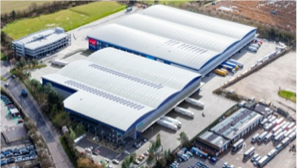Compaction applications are a required part of numerous industries, and no construction site is complete without a soil and asphalt compactor. To meet this demand, Bobcat has launched the company‘s new Light Compaction Product Line, in collaboration with the Ammann Group, a brand known for its comfort and productivity. This latest expansion of the Bobcat product range under the company’s Next is Now banner is designed to meet work requirements on almost any compaction job site. Machine specifications include state of the art technologies that allow maximum performance, while not compromising on comfort, safety and simplicity of use. Altogether, the Bobcat light compaction range comprises seven different product families and will ultimately offer 37 models, from vibratory rammers weighing 29 kg up to 2.6 tonne tandem rollers. Mike Vought, Senior Director for Product Management at Doosan Bobcat EMEA, said: “The launch of the complete compaction line-up is part of the exciting diversification strategy under our innovative Next is Now umbrella. Along with product innovations this is another driver on the way to achieving our vision – becoming the world leader in the compact equipment market. To accomplish our goals, even in the extremely difficult year of 2020, we introduced an unprecedented number of new products and technologies and we will continue this in 2021. “Compaction is one of the completely new product categories together with wheel loaders, that Bobcat introduced in 2020. This expansion was complemented by significant developments in the market-leading mini-excavator, rotary and rigid frame telehandler, skid-steer and compact track loader and backhoe loader ranges from Bobcat.” The Bobcat Light Compaction Range includes: • Vibratory rammers • Vibratory forward plates • Reversible vibratory plates • Hydrostatic plates • Walk behind rollers • Trench rollers • Tandem rollers Light compaction machines can be used in a wide range of applications, such as: Construction – Light compactors increase soil strength, improve stability and load bearing capacity by removing voids and interlocking soil particles. Roadwork – Compacting asphalt and base materials improves their capacity to withstand heavy traffic and improves their general durability. Landscaping – Rammers and forward plates are used for gardening and other landscaping applications, as their compact size and low weight ensures they are easy to move between job sites. Vibratory Rammers The Bobcat line-up of vibratory rammers consists of six models – the R30, R60, R68, R60P, R68P and R70D from 29 to 89 kg and is intended for small compaction works for trenches, drainage and pipelines. Due to their ease of transport they are often used for road maintenance as well. They are suitable for compacting mixed soils, sand, gravel materials, loam and clay. All Bobcat vibratory rammers come with a reduced vibration handle and a state-of-the-art CAD calculated weight distribution, ensuring maximum safety and operator comfort. The R60 and the models above also include an integrated height adjustment system. Vibratory Forward Plates There are also six different vibratory forward plates, which are suitable for compacting sand, gravel, lean concrete, bitumen coated gravel and paving stones. Again, their compact size makes them easy to transport between job sites, and ideal for compaction in tight spaces (trenches, pipelines and sidewalks) and even landscaping. The FP10.33, FP12.40, FP15.40, FP15.50, FP20.50 and FP20.50D models are the smallest products in the Bobcat vibratory plate offering, ranging from 54 to 115 kg. The smart engineering design of the handles protects the operator from unwanted vibration, while the machine frame enables a secure grip and easy machine control. Reversible Vibratory Plates Bobcat reversible vibratory plates are suitable for jobs mainly in civil engineering and road construction. They can easily compact all ground materials, such as sand, gravel, crushed stone, concrete and sett paving. With machine weights from 109 to 490 kg, there are 12 models in the range – the RP22.40, RP22.40D, RP25.40D, RP25.50D, RP30.50, RP30.50D, RP30.60, RP30.60D, RP40.60, RP40.60D, RP49.20D and RP59.20D. All Bobcat reversible plates operate with a twin-shaft system, enabling change of direction during compaction. The twin-shaft technology also results in dual weight and a better compaction force. Hydrostatic steering controls guarantee ease of operation and a quick change in compaction direction. Hydrostatic Plates Complementing the rest of the compaction plate range, there are four hydrostatic plates – the HP50.75, HP55.75, HP60.85 and HP65.85 models – weighing between 450 and 582 kg. Hydrostatic plates are designed for heavier compaction work in civil engineering and road construction. They can compact all ground materials – such as sand, gravel, crushed stone, asphalt and sett paving – with ease. The Bobcat hydrostatic plate line-up relies on a fully hydraulic system that does not require a V-belt. They operate with a dual (HP50.75 and HP60.85) or unique triple shaft (HP55.75 and HP65.85) excitation system for maximum compaction output and unbeatable climbing ability. Walk Behind Rollers Walk behind rollers are versatile machines, suitable for compacting bituminous material but also for light earthwork and other compaction tasks. Bobcat offers the WR65 model in two versions offering a choice between Hatz or Yanmar engines, both equipped with dual drums for maximum compaction. They are fully hydraulic machines, with an integrated water sprinkler system as standard. The Bobcat walk behind rollers are also equipped with dual amplitude settings, enabling a change between soil/gravel and asphalt/bituminous compaction in just seconds. Trench Rollers Trench rollers are mainly designed for trench compaction as their name suggests. Bobcat is offering the 1340 kg TR75 (articulated) and 1305 kg TR85S (skid-steered) models. They also cover a wide range of other applications such as pipeline construction, electric and other cable installations, whilst commercial or industrial developments and even dumpsite and landfill jobsites can take great advantage of these machines. They can be used for soil, sand or gravel compaction and can even tackle hard to compact materials such as clay. Tandem Rollers Tandem rollers are used for larger surfaces of sub-base, asphalt or other ground materials. They are mostly present in small to medium commercial development sites and road construction sites. Bobcat is looking to offer a range of five articulated ride-on











